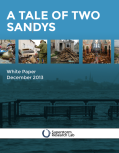A Tale of Two Sandys
 Responses to Hurricane Sandy consistently cluster into two types according to how the issues have been defined and understood. On one hand, the crisis was seen as an extreme weather event that created physical and economic damage, and temporarily moved New York City away from its status quo. On the other hand, Hurricane Sandy exacerbated crises which existed before the storm, including poverty, lack of affordable housing, precarious or low employment, and unequal access to resources generally. A Tale of Two Sandys describes these two understandings of disaster and discuss their implications for response, recovery, and justice in New York City.
Responses to Hurricane Sandy consistently cluster into two types according to how the issues have been defined and understood. On one hand, the crisis was seen as an extreme weather event that created physical and economic damage, and temporarily moved New York City away from its status quo. On the other hand, Hurricane Sandy exacerbated crises which existed before the storm, including poverty, lack of affordable housing, precarious or low employment, and unequal access to resources generally. A Tale of Two Sandys describes these two understandings of disaster and discuss their implications for response, recovery, and justice in New York City.
The white paper is based on 74 interviews with policymakers, environmental groups, volunteer first responders, and residents affected by the storm; ethnographic observation; analysis of public reports from government, community-based organizations, and other groups; qualitative analysis of canvassing forms and data; and a review of the academic literature on disaster response. As a framing document, A Tale of Two Sandys selects certain case studies for their exemplary nature, including how different groups identified vulnerable populations, timelines for aid and recovery, a case study of housing and rebuilding, and finally, urban climate change politics. The primary purpose of A Take of Two Sandys is to propose a sophisticated, accurate, and useful way of understanding the inequalities entwined with Sandy’s aftermath and to enable ways to address them.
Download A Tale of Two Sandys here.
Last update: December 21, 2013.
Citation: Superstorm Research Lab. (2013). A Tale of Two Sandys. White Paper.
Trackbacks & Pingbacks
- SRL white paper released: A Tale of Two Sandys | Superstorm Research Lab
- A Tale of Two Sandys | ashley dawson
- The cost of risk: the post-Sandy realities of flood insurance | Superstorm Research Lab
- New report on the roles of activists and community-based organizations after disasters. | Superstorm Research Lab
- A Tale of Two Sandys | Daniel Aldana Cohen
- A visual metaphor for multi-actor, mutual aid research | Daniel Aldana Cohen




Sandy has joined with Katrina and Andrew to give us a warning that means something different than it did a few decades or a century ago. Storms like these a few decades ago might have caused more deaths and less news. Storms like these a century ago would have caused far fewer deaths, by both strict numbers and by percentage of population.
There’s three reasons for this;
1. A century ago our population was less than 2 billion; today it’s more than triple that amount.
2. A few decades ago (and back to a century ago) we had far fewer warning systems in place, and far less awareness of the need to build on higher ground and to build and develop levees, dams, and dykes.
3. Up until recently (1990’s) we were not sure that we could affect the climate.
We have four choices to make; and rather than go in to details of it, let me leave you with a very intelligent, brief link that outlines, very clearly, from denier-do-nothing strategist to radical activist, what our choices. are.
http://www.upworthy.com/one-guy-with-a-marker-just-made-the-global-warming-debate-completely-obsolete-7